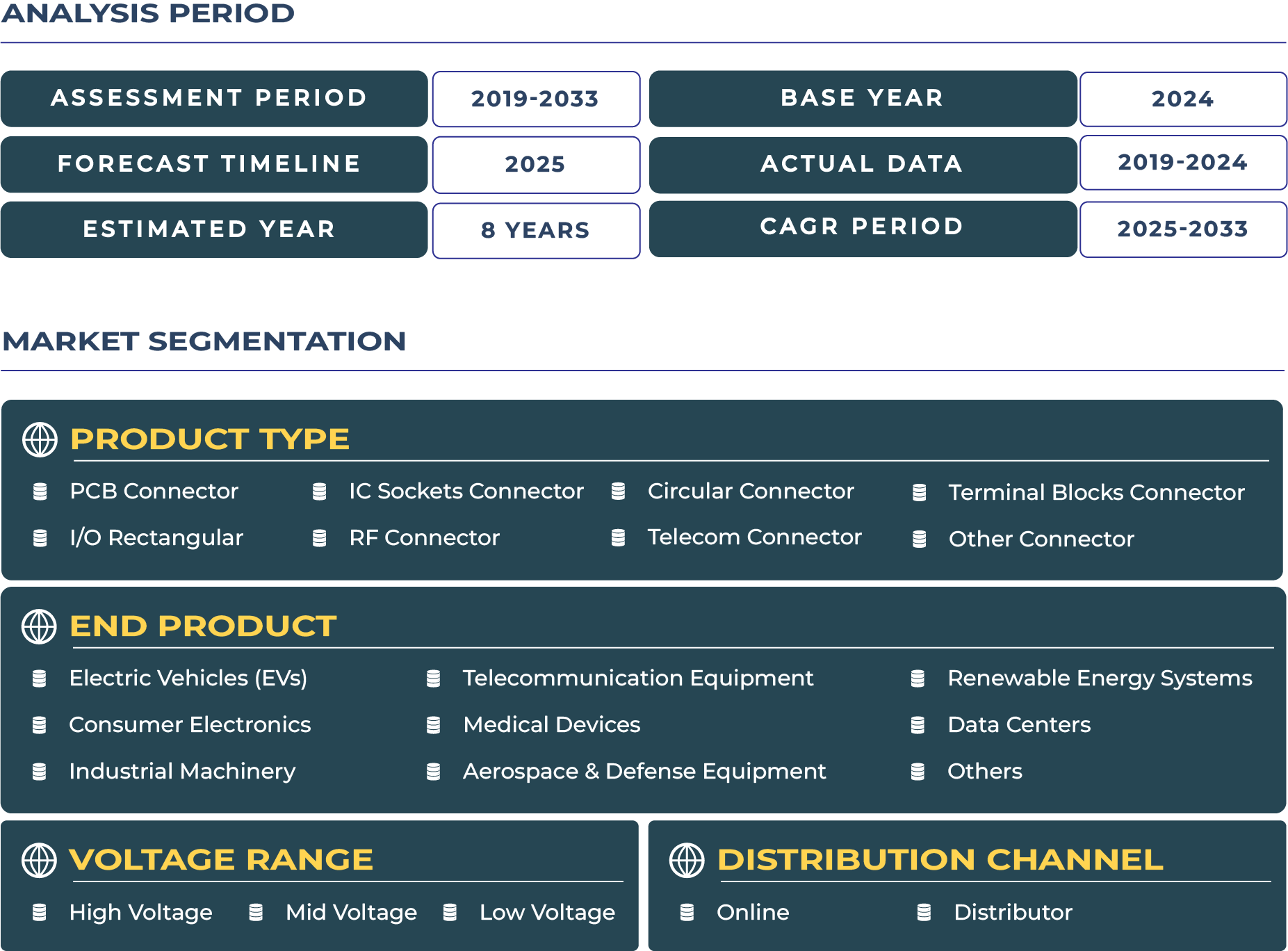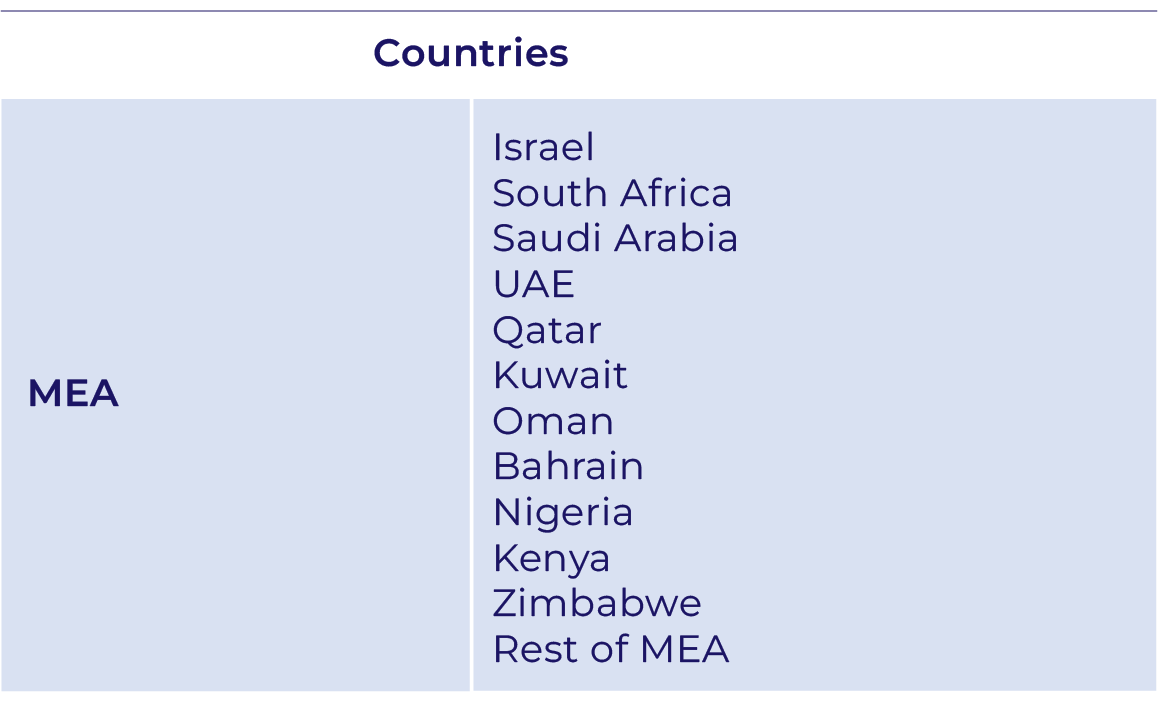MEA Connector Market Outlook
Flight-Ready and EV-Compatible Connectors in Emerging MEA Innovations
The Middle East and Africa (MEA) region is witnessing a structural transformation driven by its rapid adoption of electric mobility, unmanned aerial vehicles (UAVs), and smart infrastructure solutions. This evolution has brought the connector industry to the center stage of MEA's industrial upgrade. As aerospace corridors expand in North Africa, and electric vehicle adoption gains traction across the Gulf and Sub-Saharan economies, the demand for modular, flight-ready, and high-speed connectors has accelerated. The connector market in MEA, is projected to grow to USD 4.01 billion by 2033, registering a CAGR of 6.8% between 2025 and 2033. This expansion is supported by resilient investments in smart transportation, digital defense systems, and climate-resilient energy infrastructures.
The application of RF connectors and I/O rectangular connectors has become increasingly pronounced in MEA’s UAV and aviation sectors. Countries such as South Africa and Egypt are exploring locally designed drones and surveillance systems that require compact, thermally efficient, and rugged interconnects. Meanwhile, circular and terminal block connectors are being widely deployed in high-heat EV charging stations and battery management systems across North African and GCC nations. The increasing localization of flight electronics manufacturing and battery assembly has created a strong need for standardized connector ecosystems that can function across power, signal, and data transmission environments. This trend places connectors not merely as electrical commodities but as strategic enablers of MEA’s next-gen innovation agendas.
Infrastructure Resilience and Digital Mobility Driving Connector Industry Forward
The MEA connector market is being catalyzed by foundational changes in digital infrastructure, urban mobility, and decentralized energy. Countries such as the UAE, Morocco, and Kenya are deploying smart mobility networks where EV buses, solar-powered transit hubs, and edge computing sites require consistent signal and power connections. The rise of fast-disconnect, IP-rated connectors in these environments demonstrates a shift toward ruggedized, mission-specific interconnects that can withstand dust, temperature, and vibration.
In parallel, governments are incentivizing localized tech manufacturing to reduce dependence on imports and strengthen supply chain resilience. Kenya’s Konza Technopolis and Rwanda’s Kigali Innovation City exemplify regional efforts to establish high-tech zones with embedded electronics production capability. The deployment of modular telecom infrastructure and EV fleets across these hubs presents significant demand for I/O connectors and PCB connectors that can interface seamlessly with programmable hardware and IoT sensors. The connector landscape is further benefiting from Africa’s growing appetite for data center infrastructure, especially in Nigeria, Egypt, and South Africa, where robust IC socket connectors are essential for server-grade computing platforms.
Supply Chain Exposure and Cost Sensitivity Continue to Impede Scale
Despite the rising demand, the MEA connector sector is constrained by persistent barriers. A heavy dependence on imported connectors from East Asia and Europe creates supply chain volatility, often compounded by political instability in key importing nations. In 2024, global logistics constraints and shipping delays have led to extended lead times for critical connector components, affecting time-sensitive projects in aviation and EV rollouts.
Additionally, the sector faces cost sensitivity due to the fluctuating pricing of copper, aluminum, and rare earth materials essential to connector fabrication. Local connector manufacturers often struggle to compete with international suppliers on quality and volume, creating a quality-price dilemma for system integrators. Moreover, the shortage of technical labor proficient in connector integration and system-level testing has further limited the market's scalability in countries like Sudan, Angola, and Yemen.
EV Battery Swapping and Aerospace Modularization Paving New Growth Avenues
The MEA connector industry is embracing emerging trends that redefine connector design and deployment strategies. One of the most significant developments is the region’s experimentation with EV battery swapping models in urban centers of Morocco and Egypt. These systems require high-voltage connectors that support rapid plug-unplug cycles without thermal degradation. Fast-disconnect and arc-resistant connectors are gaining adoption in this segment.
In the aerospace sector, MEA nations are pursuing modular aircraft and UAV systems, especially for surveillance and border control. Algeria, for example, has increased its investment in modular UAV platforms where RF and PCB connectors play a central role in payload configuration flexibility and system diagnostics. The demand for lightweight and easily maintainable connectors in these platforms is encouraging innovation in composite-based connector materials that offer weight savings and high dielectric strength.
Media and Data Connectivity Hubs Generating Strategic Connector Demand
An important opportunity lies in the rise of MEA's digital media cities and connectivity corridors. With Dubai's media production zone and Cairo’s burgeoning content creation industry, there is rising demand for high-quality I/O rectangular connectors and signal converters in AV production, satellite uplinks, and live-streaming infrastructure. The growth of Arabic-language OTT platforms and e-learning ecosystems across Saudi Arabia and Nigeria is also pushing telecom-grade connector demand in edge distribution nodes.
These developments require modular connectors that ensure minimal signal loss and high durability. The expansion of fiber networks across urban and semi-urban clusters of Sub-Saharan Africa further supports the demand for high-frequency telecom connectors capable of supporting high-speed broadband delivery, especially in remote education and healthtech networks.
Strategic Regulation and Localization Mandates Reshaping Procurement Models
Several regulatory developments across MEA are helping stabilize and formalize the connector ecosystem. For example, Egypt's Ministry of Communications and Information Technology (MCIT) and Saudi Arabia’s Local Content Authority have introduced guidelines that encourage the sourcing of electronic components from local manufacturers. This push is gradually reshaping public procurement processes, with domestic connector manufacturers receiving preferential margins and technical assistance.
In addition, pan-African initiatives such as the African Continental Free Trade Area (AfCFTA) are expected to simplify cross-border component trade and harmonize compliance protocols. This may open up collaborative connector design and assembly ventures across countries like Ghana, Ethiopia, and Senegal, enabling economies of scale.
Geo-Economic Tensions, Electrification Investments, and Local Tech Manufacturing as Impact Multipliers
MEA connector market is highly sensitive to macroeconomic shifts. The ongoing tensions in the Red Sea corridor, fluctuating oil prices, and inflationary pressures across East Africa continue to affect infrastructure budgets. However, this volatility is somewhat offset by massive electrification investments. For instance, Ethiopia and Tanzania have increased investments in hydro and off-grid solar power installations, which require robust power connectors and terminal block interfaces.
Moreover, increasing governmental support for local technology parks and innovation hubs in the likes of Tunisia, Ghana, and Namibia provides a strong foundation for connector assembly and end-use integration. The availability of fiscal subsidies and special economic zones (SEZs) has enabled connector companies to set up testing and distribution bases without incurring high capex.
Connector Market Consolidation and Regional Partnerships Defining Competitive Landscape
MEA connector sector is witnessing the entry of global connector manufacturers and strategic tie-ups with regional players. Companies like TE Connectivity and Phoenix Contact continue to dominate the high-precision segments, while local players such as El Sewedy, Electro Cable Egypt, and South Africa’s CBI-Electric are forging OEM alliances to manufacture region-specific connector variants.
In March 2025, El Sewedy Electric entered into a partnership with a European firm to locally assemble smart terminal connectors for the North African EV market. Similarly, in January 2025, Kenya’s Mobius Motors integrated locally assembled RF connectors into its latest off-road EV prototype, demonstrating the feasibility of indigenous connector ecosystems. These developments signal a move toward market consolidation, with integrated value chains and modular production lines being the future of MEA’s connector landscape.
Empowering MEA's Technological Leap through Resilient Connector Systems
The MEA connector industry is no longer a passive hardware supplier but a catalyst in regional transformation. From renewable energy and next-gen vehicles to UAV deployment and digital content, connectors are powering the core of MEA’s economic leap. As policy shifts, localization initiatives, and climate adaptations intersect, the future of the connector market rests on its ability to deliver innovation-ready, modular, and cost-effective interconnects.








